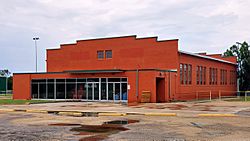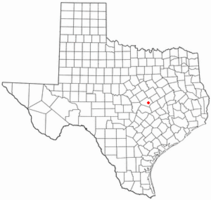Little River-Academy, Texas facts for kids
Quick facts for kids
Little River-Academy, Texas
|
|
|---|---|

1934 gymnasium in Little River-Academy
|
|

Location of Little River-Academy, Texas
|
|
 |
|
| Country | United States |
| State | Texas |
| County | Bell |
| Area | |
| • Total | 1.92 sq mi (4.96 km2) |
| • Land | 1.91 sq mi (4.95 km2) |
| • Water | 0.01 sq mi (0.02 km2) |
| Elevation | 492 ft (150 m) |
| Population
(2020)
|
|
| • Total | 1,992 |
| • Density | 1,066.46/sq mi (411.84/km2) |
| Time zone | UTC-6 (Central (CST)) |
| • Summer (DST) | UTC-5 (CDT) |
| ZIP code |
76554
|
| Area code(s) | 254 |
| FIPS code | 48-43066 |
| GNIS feature ID | 1385349 |
Little River-Academy is a city in Bell County, Texas, USA. In 2020, about 1,992 people lived there. It is part of a larger area that includes the cities of Killeen and Temple, and Fort Cavazos.
Contents
Where is Little River-Academy?
Little River-Academy is in the southeast part of Bell County. You can find it at 30°59′N 97°21′W / 30.983°N 97.350°W. The city is made up of two older towns that joined together.
One part is Little River. It is about 2 miles (3.2 km) east of where the Leon River and Lampasas River meet. When these two rivers join, they form the Little River. This river then flows into the Brazos River.
The other part is Academy. It is about 1.5 miles (2.4 km) east of Little River. Academy is centered where Main Street and Texas State Highway 95 cross. This spot is about 10 miles (16 km) south of the city of Temple.
The United States Census Bureau says Little River-Academy covers about 2.7 square miles (7.1 square kilometers). Only a tiny bit of this area, about 0.20%, is water.
People of Little River-Academy
| Historical population | |||
|---|---|---|---|
| Census | Pop. | %± | |
| 1980 | 1,155 | — | |
| 1990 | 1,390 | 20.3% | |
| 2000 | 1,645 | 18.3% | |
| 2010 | 1,961 | 19.2% | |
| 2020 | 1,992 | 1.6% | |
| U.S. Decennial Census | |||
In 2020, the city had 1,992 people living there. There were 730 households and 503 families.
Here is a look at the different groups of people living in Little River-Academy in 2020:
| Race | Number | Percentage |
|---|---|---|
| White (NH) | 1,440 | 72.29% |
| Black or African American (NH) | 12 | 0.6% |
| Native American or Alaska Native (NH) | 9 | 0.45% |
| Asian (NH) | 14 | 0.7% |
| Pacific Islander (NH) | 2 | 0.1% |
| Some Other Race (NH) | 3 | 0.15% |
| Mixed/Multi-Racial (NH) | 77 | 3.87% |
| Hispanic or Latino | 435 | 21.84% |
| Total | 1,992 |
A Look at History
A fort called Fort Griffin was built here in 1836. Early Texans settled near this fort because of conflicts with Native Americans. The railroad came to the town in 1880. A post office was opened in 1886. By 1914, about 250 people lived in the area. The towns of Little River and Academy officially joined together in 1989. This is how the city of Little River-Academy was formed.
Education
Students in Little River-Academy go to schools in the Academy Independent School District.
This school district has four schools:
- Academy Early Childhood Center
- Academy Elementary School
- Academy Middle School
- Academy High School
Academy is also home to the Bell County Alternative School. This school serves students from nearby towns like Holland, Salado, Bartlett, Troy, and Rogers.
See also
 In Spanish: Little River-Academy para niños
In Spanish: Little River-Academy para niños

